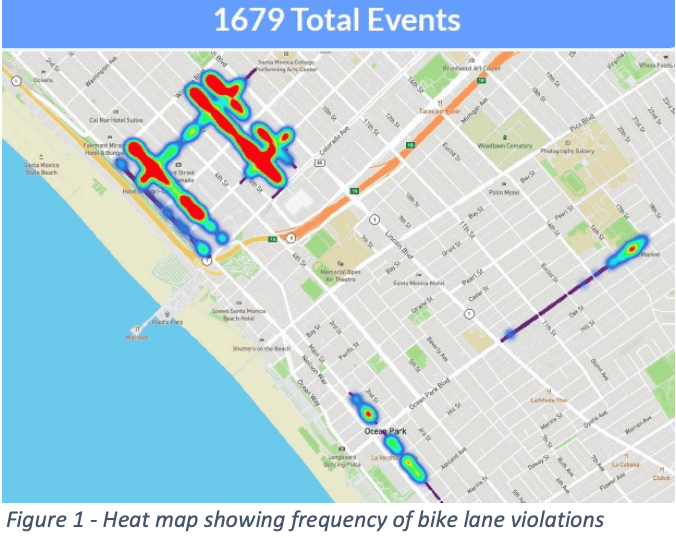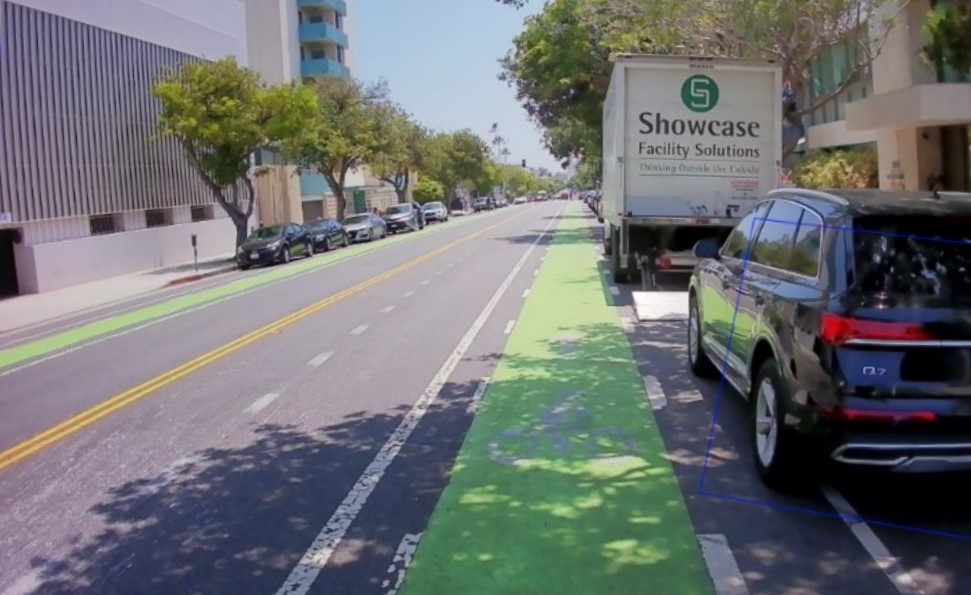This post is syndicated from SBLA sister site Santa Monica Next.
In November, the Santa Monica City Council approved a pilot program to both test the effectiveness of AI in enforcing parking laws in bicycle lanes by “identify[ing] vehicles illegally parked in those lanes," and to "provide data on how automated monitoring and enforcement could improve both the safety of bike lanes and the experience for those who use them.” The pilot program ran for six weeks from May 15 to the end of June and the results are clear: Santa Monica is experiencing an epidemic of lane violations by scofflaw drivers.
The pilot found 1,679 violations (7.7 every day) over six weeks, with 263 instances of “red flag” or “yellow flag” violations. Red flag designations are where the lane is fully or partially blocked, and yellow flag where there is a lesser encroachment. These designations were made by the vendor, Hayden AI who has been operating bus and bike lane enforcement projects throughout the country.*

The two vehicles equipped with cameras operated only on several streets in and near Downtown Santa Monica and along Ocean Park Boulevard. That means the program is a massive undercount of how many drivers illegally park in bike lanes.
The report illustrates why Santa Monica is becoming a more dangerous place to ride a bicycle, even as the city builds more and better bicycle infrastructure. Recent statistics provided by the Santa Monica Department of Transportation showed that traffic fatalities and bicycle fatalities have risen in recent years even as the city is building world-class bike infrastructure.
However, a city can build protected bike lanes on every street in the city, but if they are blocked by thousands of cars then they have no actual value and may even make streets more dangerous as lawbreakers push bicyclists out of the bike lanes into car travel lanes where drivers may not be expecting them.
Roughly ten percent of scofflaws were repeat offenders, although again given the small study area that number is also likely an undercount. Of the 160 repeat offenders, 104 drivers were responsible for two events, 42 drivers produced 3 events, and 14 drivers produced 4 or more events, with one vehicle (a food truck) observed 13 times by the system. The most frequent repeat offender in terms of red-flagged violations (often entirely blocking the bike lane) was a freight delivery truck.

This program wouldn’t have been possible just a couple of years ago. A recently passed California law authorizes public transit operators to install automated forward facing cameras on transit vehicles to enforce parking violations in bicycle lanes and designated transit stops.
The city is looking to create a permanent program of using AI and front-facing cameras to monitor and enforce bicycle and bus lane restrictions to both make the city safer and improve Big Blue Bus and Metro performance. The report, and likely a proposal for a permanent program, will be heard at a City Council meeting later this month.
Metro installed and is about to begin using on-bus cameras to enforce bus lane parking restrictions. However, the Metro program only applies to bus lanes within the city of Los Angeles.
Using cameras and AI has several advantages for the city. First, it’s clear that any SMPD efforts to protect bike and bus lanes from scofflaw drivers are a massive failure. Be it a lack of resources or the will to prioritize traffic safety through protecting bike lanes, the study makes clear that whatever the SMPD is (or isn’t) doing is not working.
The second advantage is that camera enforcement removes any biases from policing.
Regardless, SMPD will need to be a partner in any long-term program for camera enforcement going forward. Ticketing powers reside with the police department so their involvement will be critical, even if the police won’t be charged with writing tickets as part of the program
Read the city's full eight-page report: Automated Bike Lane Monitoring Pilot Update.
*Hayden AI is an advertiser with Streetsblog Los Angeles.







